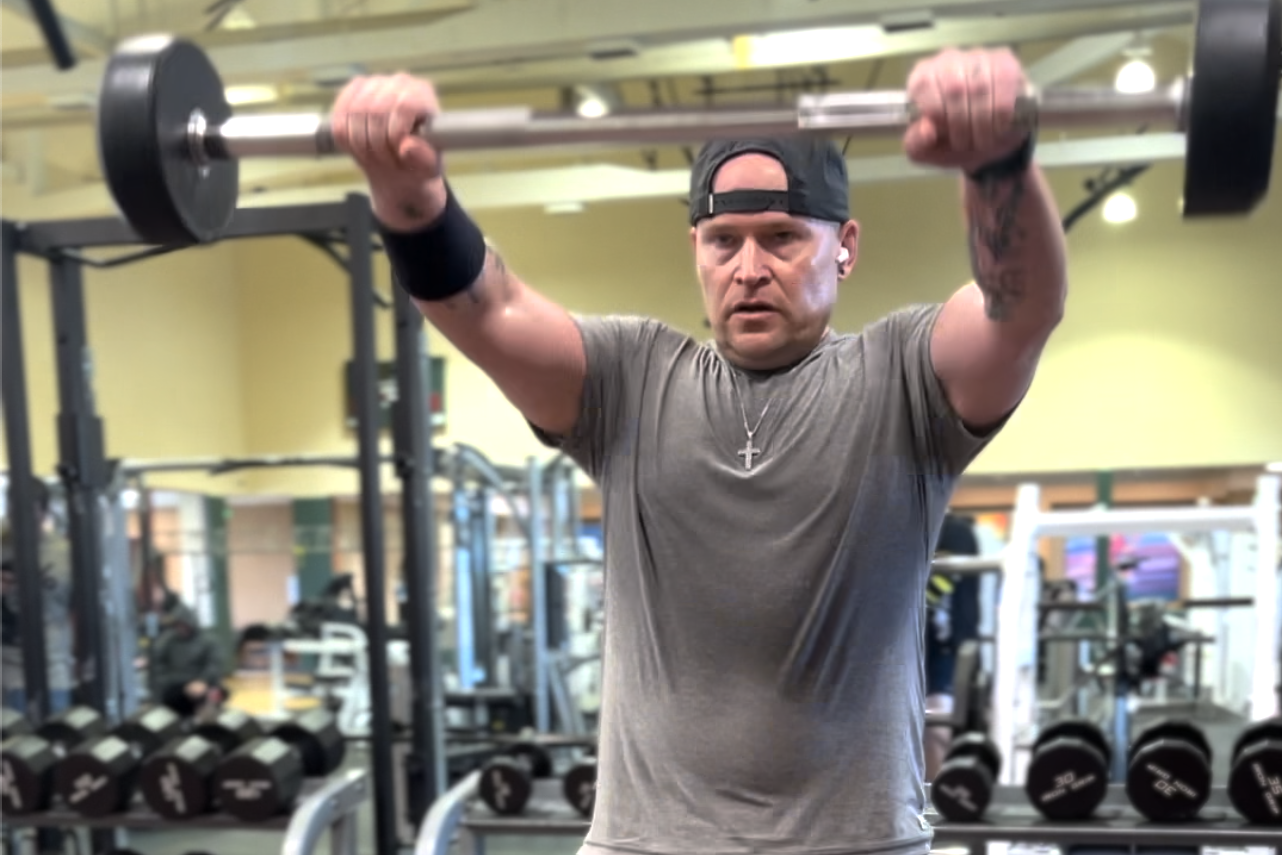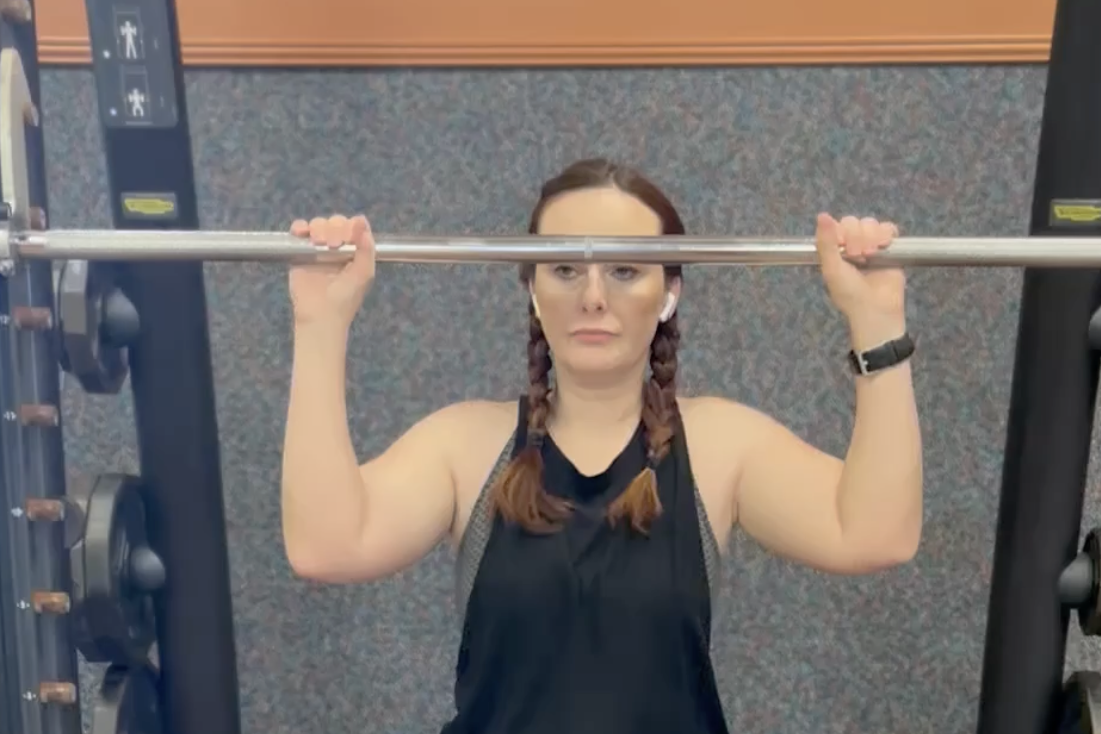Shoulder Workout 2
#ShoulderWorkout
Instructions:
Warm Up
✅ Start with a weight that is easy and does not cause strain or heavy breathing.
Reverse Pyramid
✅ On your first heavy weight: Do a weight that you can do 4-6 reps. Then decrease the weight by 10% for each of the following reps. Once you hit the max you can do, increase your weight. Rinse and repeat as you get stronger.
Rest Pause
✅ Rest Pause is 4 Rounds. The first set is larger and the other three are smaller. The weight stays the same for all rounds. If you can do 12 Reps and 6 Reps with only 15 seconds of rest easily, then increase the Rep count to 14 and 7.
Abs
✅ You have Two Options: Option 1: You can do 1 Set of 60 OR Option 2: 3 Sets of 20 (you can mix it in between the exercises as you do the workout)
The Workout
1. Cable Front Raise (Reverse Pyramid)
Example: (adjust weight according to what works best for you)
Warm up: 4-6 Reps: 30 pounds (then do 1 minute rest)
Warm up: 4-6 Reps: 40 pounds (then do 2 minute rest)
Round 1 – Do 4-6 Reps: 60 pounds (then do 3 minute rest)
Round 2 – Do 6-8 Reps: 50 pounds (then do 3 minute rest)
Round 3 – Do 8-10 Reps: 40 pounds (then do 3 minute rest)
2. Cable Front Raise (Rest Pause)
Example: (adjust weight according to what works best for you)
Round 1 – Start at 12 Reps for your first set (then do 15 second rest)
Round 2 – Do 6 Reps (then do 15 second rest)
Round 3 – Do 6 Reps (then do 15 second rest)
Round 4 – Do 6 Reps (then do 15 second rest)
3. Barbell Push Press (Reverse Pyramid)
Example: (adjust weight according to what works best for you)
Warm up: 4-6 Reps: 30 pounds (then do 1 minute rest)
Warm up: 4-6 Reps: 40 pounds (then do 2 minute rest)
Round 1 – Do 4-6 Reps: 60 pounds (then do 3 minute rest)
Round 2 – Do 6-8 Reps: 50 pounds (then do 3 minute rest)
Round 3 – Do 8-10 Reps: 40 pounds (then do 3 minute rest)
4. Barbell Push Press (Rest Pause)
Example: (adjust weight according to what works best for you)
Round 1 – Start at 12 Reps for your first set (then do 15 second rest)
Round 2 – Do 6 Reps (then do 15 second rest)
Round 3 – Do 6 Reps (then do 15 second rest)
Round 4 – Do 6 Reps (then do 15 second rest)
5. Barbell Front Raise (Reverse Pyramid)
Example: (adjust weight according to what works best for you)
Warm up: 4-6 Reps: 30 pounds (then do 1 minute rest)
Warm up: 4-6 Reps: 40 pounds (then do 2 minute rest)
Round 1 – Do 4-6 Reps: 60 pounds (then do 3 minute rest)
Round 2 – Do 6-8 Reps: 50 pounds (then do 3 minute rest)
Round 3 – Do 8-10 Reps: 40 pounds (then do 3 minute rest)
6. Barbell Front Raise (Rest Pause)
Example: (adjust weight according to what works best for you)
Round 1 – Start at 12 Reps for your first set (then do 15 second rest)
Round 2 – Do 6 Reps (then do 15 second rest)
Round 3 – Do 6 Reps (then do 15 second rest)
Round 4 – Do 6 Reps (then do 15 second rest)
7. Abs: Knee Raise
Two Options:
Option 1: One Set of 60
Option2: 3 Sets of 20 – You can mix it in between the exercises as you do the workout.
8. Abs: Straight Leg Barbell Sit Up
Two Options:
Option 1: One Set of 60
Option 2: 3 Sets of 20 – You can mix it in between the exercises as you do the workout.



Shoulder Workout 2
When it comes to developing well-rounded strength and a balanced physique, few areas of the body are as crucial as the shoulders. Strong shoulders not only enhance your overall physical appearance by broadening your frame and adding to the symmetry of your upper body, but they also play a vital role in the functionality and stability of nearly every upper body movement. Among the many shoulder exercises you can incorporate into your fitness routine, three particularly effective ones stand out: the Cable Front Raise, the Barbell Push Press, and the Barbell Front Raise. Each of these exercises targets different areas of your deltoids, helping you build both size and strength while enhancing shoulder mobility and endurance.
The Importance of Shoulder Workouts
Before diving into the specifics of each exercise, it’s important to understand why shoulder workouts are vital not just for aesthetic reasons, but for improving overall athletic performance and preventing injuries. The shoulder is one of the most mobile joints in the body, and this range of motion allows for a wide array of movements in multiple planes; however, this same mobility makes the shoulder joint vulnerable to injury, especially if the muscles around it aren’t strong enough to support the joint during strenuous activity. Strengthening the shoulder muscles—specifically the deltoids, which are the large, rounded muscles at the top of your arms—is essential for protecting the joint, improving posture, and enhancing your ability to perform both in the gym and in daily activities.
Moreover, strong shoulders contribute significantly to the performance of compound lifts such as the bench press, deadlift, and squat. Without adequately developed shoulders, you may find it difficult to lift heavy weights, as your shoulder strength often limits your ability to perform pressing movements. Additionally, shoulder strength is crucial for athletes who rely on throwing, swinging, or pushing motions, including those in sports such as tennis, baseball, football, and swimming. Thus, incorporating a variety of shoulder exercises, like the Cable Front Raise, Barbell Push Press, and Barbell Front Raise, into your workout routine is an effective way to ensure that your shoulders are not just big but also functional and resilient.
Cable Front Raise: How to Perform It and Its Benefits
The Cable Front Raise is an isolation exercise that primarily targets the anterior (front) deltoid, which is a muscle often neglected in comparison to the lateral (side) and posterior (rear) deltoids. This exercise is particularly effective for improving the appearance of your shoulders by giving them a more rounded, fuller look; it also helps to enhance strength and endurance in the front of the shoulder, which is essential for pressing movements.
How to Perform the Cable Front Raise:
- Set Up: Attach a straight bar or a rope attachment to the low pulley on a cable machine. Stand facing away from the machine with your feet shoulder-width apart, and grasp the bar or rope with both hands using an overhand grip.
- Positioning: With your arms fully extended and slightly in front of your body, make sure your torso is upright and your core is engaged. Your arms should be just above your thighs before you begin the lift.
- Execution: Slowly raise the bar or rope to the height of your shoulders while keeping your arms straight. Make sure to lift in a controlled manner, avoiding any jerking or swinging motions. Hold the top position for a second, then slowly lower the bar back to the starting position.
- Reps and Sets: Aim for 3-4 sets of 10-15 repetitions, focusing on form over the weight you’re lifting.
Benefits of the Cable Front Raise:
One of the primary benefits of the Cable Front Raise is that it targets the anterior deltoid more effectively than many other shoulder exercises. Since the movement is isolated, it ensures that the front delts are doing all the work, allowing you to strengthen this often-underdeveloped area. Additionally, the use of cables provides constant tension throughout the movement, which helps in building both strength and endurance more effectively than free weights in some cases. This exercise also has carryover benefits for your pressing power, making movements like the bench press and overhead press easier and more efficient.
Barbell Push Press: How to Perform It and Its Benefits
The Barbell Push Press is a compound exercise that engages not only your shoulders but also your entire upper body, core, and legs. Unlike strict shoulder presses, which rely solely on the shoulders to lift the weight, the push press allows you to generate momentum from your lower body to help press the barbell overhead; this makes it an excellent exercise for building explosive strength and power.
How to Perform the Barbell Push Press:
- Set Up: Begin by setting a barbell at shoulder height in a squat rack. Grasp the barbell with a shoulder-width grip and position it across your upper chest, with your elbows pointing slightly forward.
- Positioning: Stand with your feet shoulder-width apart, and engage your core to stabilize your spine. The barbell should be resting across your collarbone, with your chest up and your back slightly arched.
- Execution: Bend your knees slightly and explosively push through your legs while simultaneously pressing the barbell overhead. Your arms should extend fully overhead, and your legs should straighten by the time the bar is overhead.
- Lowering: Lower the barbell back to the starting position in a controlled manner, and immediately prepare for the next rep.
- Reps and Sets: Perform 4-5 sets of 5-8 repetitions, as this exercise works well with heavier weights and lower rep ranges.
Benefits of the Barbell Push Press:
The Barbell Push Press offers several advantages, particularly for those looking to build explosive power and improve their overall upper-body strength. Since this movement involves your legs, core, and shoulders, it allows you to lift more weight than you could with a standard overhead press, thereby stimulating greater muscle growth. The push press also improves coordination between your upper and lower body, enhancing your ability to generate force from the ground up. This has excellent carryover to athletic activities like sprinting, jumping, and throwing. Additionally, because the push press is a compound movement, it burns more calories than isolation exercises, making it a great addition to any fat-loss or strength-building program.
Barbell Front Raise: How to Perform It and Its Benefits
The Barbell Front Raise is another isolation exercise that, much like the Cable Front Raise, primarily targets the anterior deltoid; however, using a barbell instead of cables or dumbbells allows for greater loading potential, which can lead to increased strength and muscle mass in the front delts over time.
How to Perform the Barbell Front Raise:
- Set Up: Hold a barbell with both hands using an overhand grip, slightly wider than shoulder-width apart. Stand with your feet shoulder-width apart and your core engaged.
- Positioning: Let the barbell hang in front of your thighs, with your arms fully extended and your elbows slightly bent to reduce strain on your joints.
- Execution: Keeping your arms straight, raise the barbell to shoulder height while maintaining control of the movement. Avoid using your lower back or swinging your body to lift the weight; the movement should come entirely from your shoulders.
- Lowering: Slowly lower the barbell back to the starting position, ensuring that you’re controlling the descent of the weight.
- Reps and Sets: Aim for 3-4 sets of 8-12 repetitions, using a moderate weight that challenges you but allows you to maintain perfect form.
Benefits of the Barbell Front Raise:
The Barbell Front Raise is a great way to develop the front delts, as it allows you to use more weight than you typically would with dumbbells or cables. This increased resistance helps to build muscle mass and strength in the anterior deltoids, which can improve your pressing movements and contribute to a more well-rounded, aesthetically pleasing upper body. Additionally, strengthening the front delts helps to improve shoulder stability and reduce the risk of injury, especially during heavy lifting. The controlled nature of this exercise also helps to improve mind-muscle connection, which is essential for muscle hypertrophy.
Enhance Your Workouts with Pearce Fitness
Shoulder training should be an integral part of any well-rounded fitness routine, and incorporating exercises like the Cable Front Raise, Barbell Push Press, and Barbell Front Raise is a fantastic way to target all areas of the deltoids, ensuring both strength and size development. These exercises not only improve the appearance of your shoulders but also enhance your overall athletic performance by strengthening key muscles that support pressing, lifting, and throwing movements.
At Pearce Fitness, we understand the importance of effective, well-structured workouts that target every aspect of fitness. If you’re looking to optimize your shoulder training, we offer personalized workout plans that incorporate these exercises and many others to help you achieve your fitness goals. Be sure to follow us on YouTube at @pearcemfitness for more exercise tips, demonstrations, and full workout routines designed to help you build strong, functional shoulders and much more. With our guidance, you’ll be on your way to developing the strength and physique you’ve always wanted.
